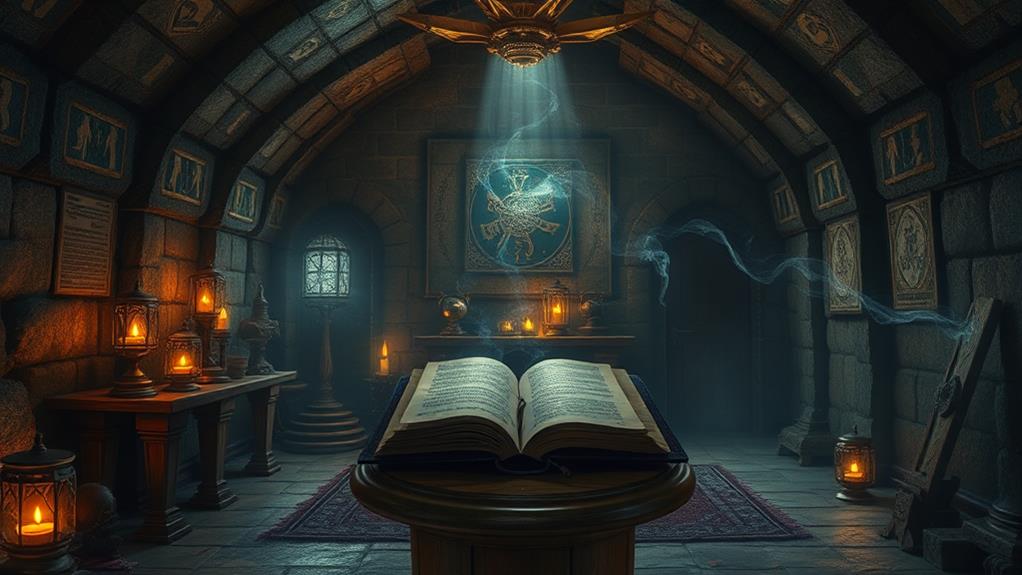
You're about to uncover the ancient roots of spell casting, beginning with the rituals of Mesopotamians who sought divine favor through temple ceremonies and clay tablets. Egyptians used orphic hymns and amulets, believing in the power of words. Greeks and Romans blended their customs with Egyptian teachings, invoking deities like Hecate and Hermes. Druids enchanted groves and waters, connecting with nature's spirits. African tribes used music, dance, and artifacts, while Asian cultures incorporated mantras and prayers to kami. Indigenous Americans respected the land's spirit with shamanic practices. Each culture offers fascinating insights into the diverse origins of spell casting practices.
Ancient Mesopotamian Practices
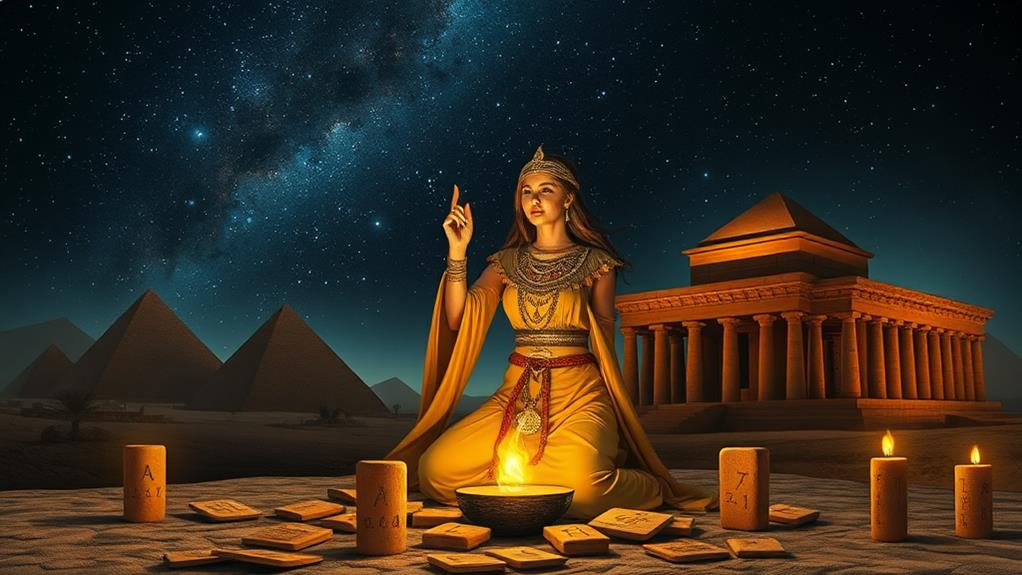
Ancient Mesopotamian practices of spell casting offer a fascinating glimpse into the spiritual life of one of humanity's earliest civilizations. You'd find that these ancient people believed in a complex world of gods, spirits, and supernatural forces. They used spells for protection, healing, and ensuring good fortune. The priests, often known as "ashipu" or "baru," played vital roles in these rituals, invoking divine powers to intercede on behalf of individuals or communities.
When casting spells, Mesopotamians employed various materials and methods. Clay tablets inscribed with cuneiform script contained incantations and instructions for rituals. You'd see amulets and figurines crafted to ward off evil spirits or attract positive energy. Water, oil, and various herbs were also commonly used in purification rites.
The rituals often took place in temples or sacred spaces, emphasizing the importance of location and environment. You'd observe that they chanted prayers and performed symbolic actions, such as burning incense or making offerings. These practices weren't merely superstitions; they were deeply embedded in the culture, reflecting a worldview where the spiritual and physical dimensions were intimately connected.
Egyptian Magical Traditions
Mysticism permeated every aspect of Egyptian life, weaving a rich tapestry of magical traditions that captivated the imagination. You'd find magic deeply embedded in their daily routines, religious practices, and medical treatments. Egyptians believed in the power of words, and spells were often written on papyrus, amulets, and tomb walls to guarantee protection and prosperity.
In Egyptian mythology, deities like Isis and Thoth were revered as powerful magicians. You'd see priests invoking their names during rituals aimed at healing the sick or safeguarding the dead in the afterlife. These rituals often involved complex incantations, symbolic gestures, and the use of sacred objects.
One fascinating aspect was the "Book of the Dead," a collection of spells designed to guide the deceased through the underworld. By reciting these spells, Egyptians believed they could secure a favorable judgment from Osiris, the god of the afterlife.
You'd also encounter everyday magic in love spells, protection charms, and fertility rites. Egyptians used enchanted items like scarabs and eye amulets to ward off evil and attract good fortune. Fundamentally, Egyptian magical traditions were a potent blend of religion, mythology, and practical needs, seamlessly integrated into the fabric of their civilization.
Greek and Roman Influence
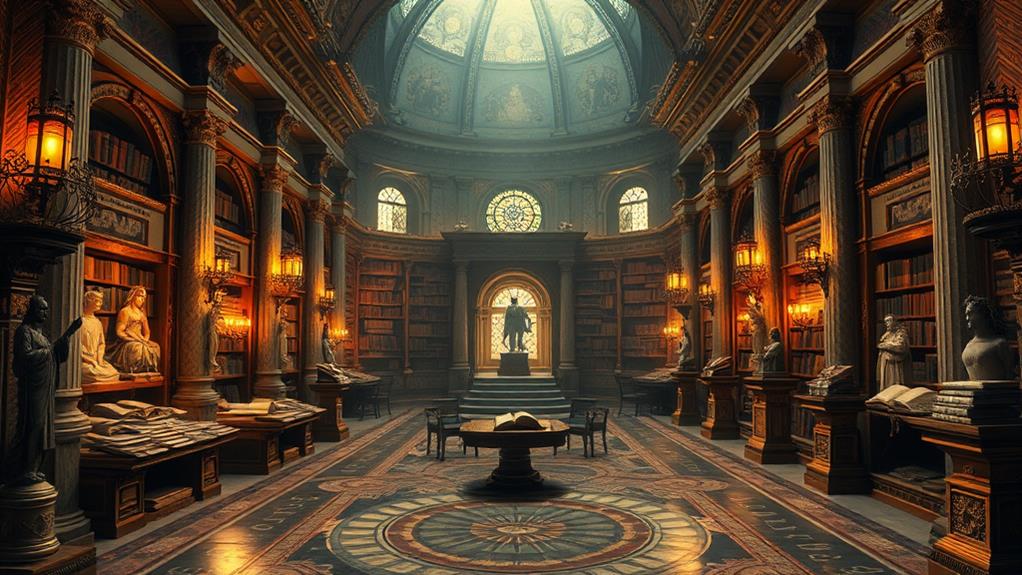
Greek and Roman civilizations profoundly impacted the development of magical traditions, blending their own practices with those of earlier cultures like the Egyptians. When you explore their contributions, you'll find that they enriched spell casting by integrating mythological elements, complex rituals, and a pantheon of deities.
Both Greeks and Romans believed in the power of spoken words and symbols. The Greek tradition of invoking gods like Hecate for protection or Hermes for travel merged seamlessly with Roman practices. You'd often see Romans adopting Greek deities, renaming them, and incorporating them into their own rituals.
| Element | Greek Influence | Roman Influence |
|---|---|---|
| Deities | Hecate, Hermes | Diana (Artemis), Mercury (Hermes) |
| Rituals | Orphic hymns, Pythagorean symbols | Augury, Lustratio (purification rituals) |
| Texts | The Greek Magical Papyri | Latin spell books like "Picatrix" |
| Tools | Knucklebones (astragali), amulets | Lead curse tablets, lares figurines |
Incorporating these elements, you'd see how the fusion of Greek and Roman practices created a rich tapestry of magical traditions. They laid the groundwork for modern spell casting, influencing the way enchantments and rituals are performed today. So, when you cast a spell, remember that you're invoking a history that spans millennia.
Celtic Druidic Spells
Celtic druidic spells offer a unique glimpse into a world where nature and spirituality are deeply intertwined. As you explore these ancient practices, you'll find that the Druids, the priests, and scholars of ancient Celtic societies, revered the natural world as a source of divine power. They believed! every tree, stone, and river held spiritual significance and could be called upon in their rituals.
To cast a druidic spell, you'd typically start by selecting natural elements like oak leaves, mistletoe, or spring water, each chosen for its unique properties. Druidic spells often involved chanting incantations in the ancient Celtic language, invoking deities or natural spirits for guidance and intervention. You'd perform these rituals in sacred groves or near bodies of water, places considered to be portals to the spiritual dominion.
The purpose of these spells varied widely. Some aimed to heal the sick, protect warriors in battle, or guarantee a bountiful harvest. Others sought to gain wisdom, foresee the future, or honor the gods. By understanding and utilizing these ancient practices, you'd connect deeply with the rhythms of nature and the divine forces that the Druids held sacred.
African Tribal Rituals
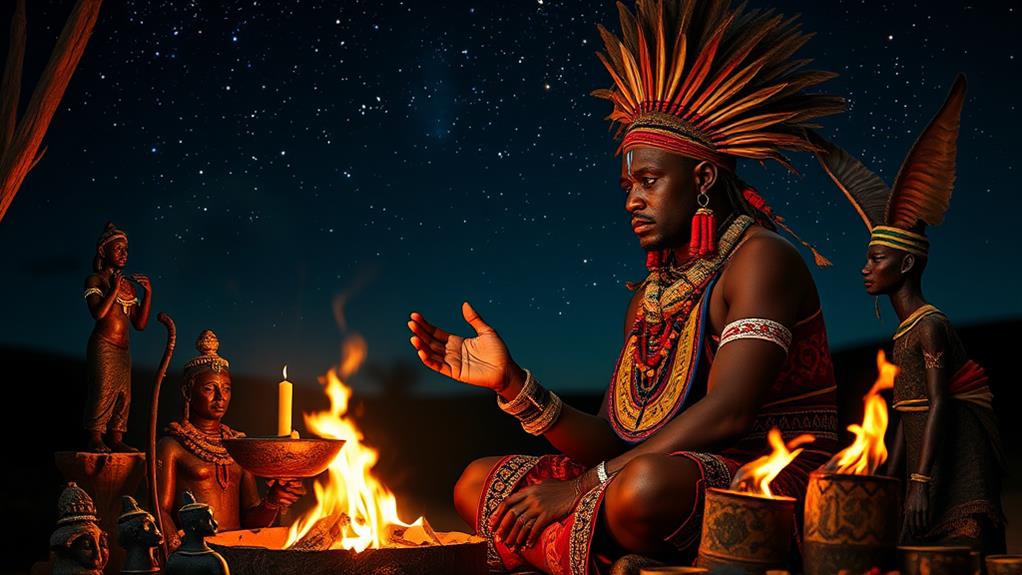
African tribal rituals offer a rich tapestry of spiritual practices that have been passed down through generations. When you explore into these traditions, you'll find a variety of ceremonies designed to honor ancestors, invoke spirits, and seek guidance. Each tribe has its unique methods, often involving music, dance, and symbolic artifacts.
In many African cultures, the act of spell casting is deeply intertwined with daily life. You might witness a shaman, known as a "sangoma" or "babalawo," performing rituals to heal the sick or protect the community. These spiritual leaders use natural elements like herbs, bones, and shells to connect with the spiritual domain.
Don't be surprised if you see intricate dances and hear rhythmic drumming; these are more than mere performances. They're essential parts of the ritual, meant to create an atmosphere conducive to spiritual communication. You'll likely notice the use of masks and costumes, which symbolize various deities and spirits.
Participating in or observing these rituals offers a glimpse into a world where the spiritual and physical domains coexist. By understanding these practices, you gain a deeper appreciation for the profound wisdom embedded in African tribal traditions.
Asian Mystical Arts
When you plunge into the domain of Asian mystical arts, you're entering a world teeming with ancient wisdom and profound spiritual practices. In countries like China, Japan, and India, spell casting merges seamlessly with cultural traditions and spiritual beliefs.
In China, Taoist spell casting involves intricate rituals to harness the energies of nature, using talismans and incantations to ward off evil spirits or attract good fortune. You might find yourself creating a Fu talisman or practicing Qigong to balance your inner energies.
Japan's mystical arts often center around Shinto and Buddhist practices. Here, spells are woven through rituals and prayers to kami (spirits) and Bodhisattvas. Omamori amulets and ofuda talismans are common tools, believed to offer protection and blessings.
India's rich tapestry of mystical practices is deeply rooted in Hinduism and Buddhism. Spell casting often involves mantras, yantras, and mudras—sacred sounds, geometric symbols, and hand gestures designed to invoke divine energies. You might chant a mantra to invoke a deity's protection or use a yantra in meditation to focus your intentions.
In each tradition, the spell caster's intent and spiritual alignment play vital roles, making Asian mystical arts a deeply personal and transformative journey.
Indigenous American Magic
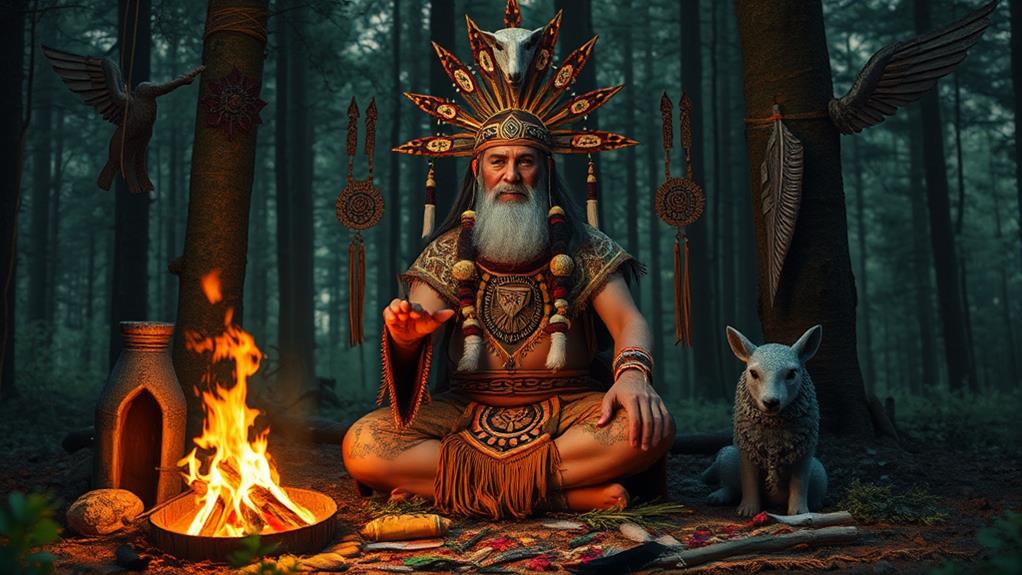
Indigenous American magic is a rich tapestry of spiritual practices and rituals deeply connected to the land and its natural cycles. You'll find that these traditions are not just about casting spells but about honoring the Earth and its spirits. Shamans, or medicine men and women, play a central role, using their deep knowledge of herbs, chants, and dances to heal and guide their communities.
In your exploration, you'll notice the profound respect for animals, plants, and celestial bodies. Totem animals, for instance, are believed to be spiritual guides that offer protection and wisdom. You might also encounter the use of sacred objects like dream catchers, which filter out negative energies and protect the sleeper.
Ceremonies often align with seasonal changes, embodying the belief that human life is intertwined with nature's rhythms. The use of smudging, where sage or other herbs are burned to purify spaces and people, is a common practice. These rituals aren't just historical; they're living traditions that continue to evolve while preserving their core principles.
At a Glance
You've journeyed through the rich tapestry of spell casting, tracing its roots from ancient Mesopotamian practices to the mystical arts of Asia. Each culture, like threads in a vast quilt, has contributed to the intricate patterns of magical traditions. By understanding these diverse origins, you're not just learning history; you're discovering a treasure trove of wisdom. So, embrace this knowledge and let it spark your curiosity and wonder, as magic continues to weave its way through time.





